BIM Integration: Seamless Construction Workflow
In today's dynamic construction landscape, efficiency and accuracy are paramount. Building Information Modeling (BIM) has emerged as a game-changer, offering a powerful solution for streamlining workflows and minimizing costly errors. This comprehensive guide explores the transformative impact of BIM integration on construction projects, highlighting its practical applications and the significant benefits it delivers.
What is BIM Integration?

BIM integration refers to the seamless connection and exchange of data between different BIM software applications and other project management tools. It's not merely about using BIM software; it's about leveraging its full potential by integrating it with other systems involved in the construction lifecycle. This interconnectedness ensures that everyone involved – architects, engineers, contractors, and owners – works with the same, up-to-date information, eliminating conflicts and promoting collaboration.
Key Benefits of BIM Integration in Construction

- Improved Collaboration: BIM integration fosters seamless communication and data sharing among all project stakeholders. This centralized platform eliminates version control issues and ensures everyone is on the same page.
- Reduced Errors and Rework: By integrating design, engineering, and construction data, BIM helps identify clashes and potential problems early in the process, reducing costly rework and delays.
- Enhanced Efficiency: Automated processes and data analysis capabilities within BIM software streamline workflows, saving time and resources throughout the project lifecycle.
- Better Cost Control: BIM allows for accurate cost estimations and tracking, enabling better budget management and minimizing cost overruns.
- Improved Project Scheduling: BIM integration facilitates realistic scheduling and progress monitoring, helping keep projects on track and within budget.
- Enhanced Safety: BIM can be used to identify potential safety hazards early on, allowing for proactive measures to mitigate risks and improve worker safety.
- Sustainable Design: BIM allows for the integration of sustainability data, helping to optimize energy efficiency and minimize the environmental impact of the project.
Real-World Applications of BIM Integration
The applications of BIM integration are vast and extend across various project types and scales. Here are some examples:
1. Clash Detection and Resolution:
BIM software can detect clashes between different building systems (e.g., MEP and structural elements) before construction begins. This early identification allows for timely design adjustments, preventing costly rework on-site.
2. 4D BIM for Construction Sequencing:
Integrating BIM with scheduling software creates 4D BIM models, visualizing the construction process over time. This allows contractors to optimize sequencing, identify potential delays, and improve resource allocation.
3. 5D BIM for Cost Estimation and Control:
By linking BIM models with cost databases, 5D BIM provides real-time cost estimations and tracking. This allows for better budget control and proactive management of cost overruns.
4. Prefabrication and Modular Construction:
BIM is crucial for prefabrication and modular construction. Precise 3D models enable accurate fabrication of components off-site, minimizing on-site work and improving construction speed and quality.
5. Facility Management:
BIM models can be used for facility management, providing a comprehensive digital twin of the building that can be used for maintenance, repairs, and upgrades throughout the building's lifecycle.
Choosing the Right BIM Integration Strategy

Implementing BIM integration requires careful planning and consideration. Factors to consider include:
- Project Size and Complexity: The level of BIM integration required will vary depending on the size and complexity of the project.
- Software Selection: Choosing compatible BIM software and other related applications is crucial for seamless data exchange.
- Team Training and Expertise: Proper training and expertise are essential for effective use of BIM software and integration tools.
- Data Management: Establishing a robust data management strategy is crucial for maintaining data integrity and accessibility.
ArchNav: Your Partner in BIM Integration
ArchNav understands the complexities of BIM integration and offers comprehensive services to help you leverage its full potential. Our team of experienced professionals provides expert guidance on BIM implementation, data management, and visualization, ensuring seamless integration across your projects. We use cutting-edge technology to create stunning and informative visualizations, bridging the gap between design and reality. Contact us today to discuss your BIM integration needs and discover how we can help you achieve a more efficient and successful construction process.
